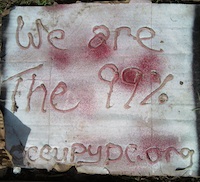|
Today's Opinions, Tomorrow's Reality
Not Too Shabby By David G. Young Washington, DC, November 1, 2011 -- The upper part of "the other 99 percent" has more in common with the rich than they think. The rowdy malcontents claiming to occupy Washington DC do so from a pair of tiny encampments just east of the White House. Their numbers are much smaller than their New York cohorts, but their slogans are pretty much the same. Most common and is the boast that they are standing up for "the other 99 percent" who have been exploited by the rich. Their vantage point from the northernmost camp, on the edge of Washington's K Street lobbying district, is an appropriate venue for this grievance. After lobbyists delivered morally dubious government bailouts of Wall Street firms, banks, and America's auto industry, such ideas have not just populist attraction, but also basis in fact.
Statistics actually do back up the protesters' idea of rising income disparity in the United States. A recent CBO report found that inflation-adjusted income of the top one percent of households had more than tripled from 1979 to 2007, compared with an increase of less than 50 percent for American households in the middle 20th to 80th percentiles of income, and even smaller gains at lower income brackets.1 When measured another way -- as a shares of the entire national income -- the same report that the share going to the top one percent more than doubled, with the share of income going to all other brackets either remaining flat or declining.2 While this certainly sounds bad, the flip side is that the same data show that all household income groups, even the bottom 20th percentile, made more money adjusted for inflation in 2007 than they did in 1979.3 Every group was richer. So does it really matter that the rich are doing much, much better and the other 99 percent is only doing a little better? Judging by the tenacity of the occupy movement, it certainly does matter to some people. Big differences in wealth between in a society aren't good for social or cultural cohesion -- it makes it difficult for poorer people to relate to the lives of richer folks, and vice versa. Recall the in the last election that Republican presidential candidate John McCain couldn't remember how many homes he owned. But the growing rift between the rich and the rest of us is probably not as important to society as the growing rift between the upper-middle class and the working class, which has an alarmingly high jobless rate. In September, the unemployment rate for those without a college diploma was 14 percent and for those with high school but no college, 9.7 percent. Yet only 4.3 percent of college graduates were unemployed.4 The truth is that America's professional class has done pretty well over the past two decades, according to the CBO report. These people are highly concentrated above the 80th percentile of income -- about 27 percent of Americans have finished a four-year college5. The people at the very start of this income group went from making $51,000 inflation adjusted dollars in 1979 to $71,000 in 2007. Those in the middle of the group went form $66,000 to $99,000 over the same period.6 Not too shabby. By this measure, it's not really the "other 99 percent" that has cause to be upset with the status quo, but something closer to the bottom half. These are the predominantly working class folks who didn't go to college and find themselves disproportionately unemployed, disproportionately underwater on their mortgages, and facing a lower standard of living than the generation who came before. The phenomenon of the decline of the working class is hardly a new story -- it has been discussed for decades, and has been infused in pop culture since at least 1982 when Billy Joel's Allentown lamented that "they're closing all the factories down". For younger Americans who chose not to go to college despite ample warnings about the consequences, it's hardly fair to blame the rich. Sounds like it's time to occupy a classroom. If there's some solace for the blame the rich camp, it comes from more recent statistics. While the CBO study only went through 2007, other figures show that the top one percent didn't do so well since the recession started. While there were 4.5 million households that reported $200,000 or more of income to the IRS in 2007, two years later this number plummeted to 3.9 million.7 On the other end of the income spectrum, the number of people making less than $10,000 per year also declined (slightly) over this same period.8 These numbers suggest a flattening of the income distribution since the recession started. So there you have it. While three decades of economic growth benefited everyone, it especially benefited the rich, making egalitarians mad. Then "the great recession" came along to cut folks down to size, hurting most all Americans, but especially the top one percent. Happy now? Related Web Columns: Dead Wood Notes: 1. Congressional Budget Office, Trends in the Distribution of Household Income Between 1979 and 2007, October 2011 2. Ibid. 3. Ibid. 4. Bureau of Labor Statistics, Employment Status of the Civilian Population 25 years and Over by Educational Attainment, October 7, 2011 5. U.S. Census Bureau, Educational Attainment in the United States: 2010 - Detailed Tables, April 21, 2011 6. CBO, Ibid. 7. IRS, Selected Income and Tax Items, by Size and Accumulated Size of Adjusted Gross Income, Tax Year 2007 and 2009 8. Ibid. |


